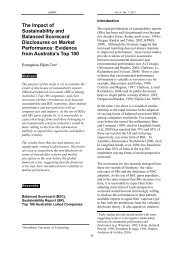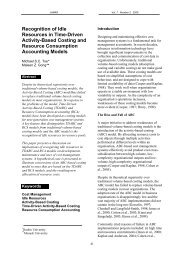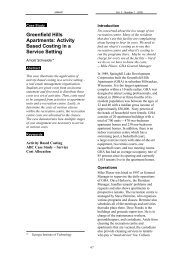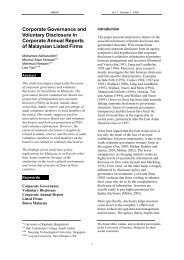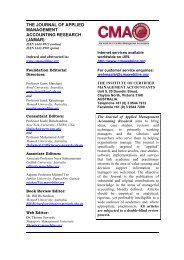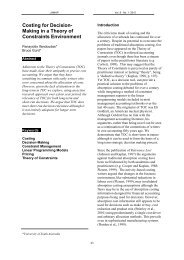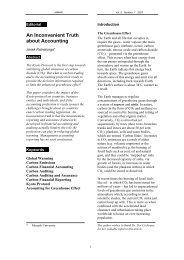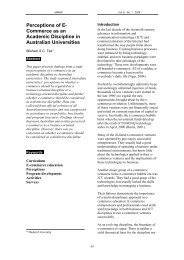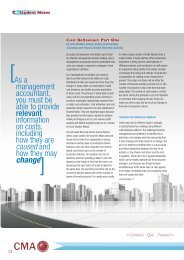Investigating the Determinants of Perceived Procedural Fairness in ...
Investigating the Determinants of Perceived Procedural Fairness in ...
Investigating the Determinants of Perceived Procedural Fairness in ...
- No tags were found...
You also want an ePaper? Increase the reach of your titles
YUMPU automatically turns print PDFs into web optimized ePapers that Google loves.
JAMAR Vol. 11 · No. 1 2013<strong>Procedural</strong> <strong>Fairness</strong>This variable is measured us<strong>in</strong>g a four-item<strong>in</strong>strument developed by McFarl<strong>in</strong> andSweeney (1992). In management account<strong>in</strong>gstudies it has been used by, for example, Lauand Sholih<strong>in</strong> (2005) and Lau and Tan (2006).Respondents were requested to rate <strong>the</strong>fairness <strong>of</strong> <strong>the</strong> procedures used to evaluate<strong>the</strong>ir performance, to communicateperformance feedback, and to determ<strong>in</strong>e <strong>the</strong>irpay <strong>in</strong>creases and promotion, rang<strong>in</strong>g from 1(very unfair) to 7 (very fair).Participation <strong>in</strong> Target Sett<strong>in</strong>gTo measure this variable, respondents wereasked to <strong>in</strong>dicate <strong>the</strong>ir level <strong>of</strong> agreementus<strong>in</strong>g a 7-po<strong>in</strong>t Likert-type scale, rang<strong>in</strong>g fromstrongly disagree to strongly agree, on a s<strong>in</strong>gleitem <strong>of</strong> “my superior allows me to participate<strong>in</strong> sett<strong>in</strong>g my performance goals/targets”. Thismeasure is adapted from <strong>the</strong> goal-sett<strong>in</strong>gquestionnaire developed by Locke and Latham(1984).Goal-Atta<strong>in</strong>ment-Reward L<strong>in</strong>kTo measure this variable, respondents wereasked to <strong>in</strong>dicate <strong>the</strong>ir level <strong>of</strong> agreementus<strong>in</strong>g a 7-po<strong>in</strong>t Likert-type scale, rang<strong>in</strong>g fromstrongly disagree to strongly agree, on a s<strong>in</strong>gleitem <strong>of</strong> “my rewards are tied to <strong>the</strong>achievement <strong>of</strong> <strong>the</strong> performance goals”. This<strong>in</strong>strument is adapted from Kom<strong>in</strong>is andEmmanuel (2007).Goal SpecificityTo measure goal specificity, three items weretaken from Fang et al. (2005): (1) my superiorspecifically expla<strong>in</strong>ed what my performancegoals are; (2) I have very specific performancegoals <strong>in</strong> my job; and (3) I understand <strong>the</strong> exactlevel <strong>of</strong> my assigned performance goals.Respondents were requested to <strong>in</strong>dicate <strong>the</strong>irlevel <strong>of</strong> agreement to <strong>the</strong> above items, us<strong>in</strong>g aseven-po<strong>in</strong>t Likert-type scale rang<strong>in</strong>g from 1(strongly disagree) to 7 (strongly agree).Performance MeasureThe performance measure is employed as <strong>the</strong>controll<strong>in</strong>g variable. To measure this variable,respondents were requested to <strong>in</strong>dicate howmuch importance <strong>the</strong>y thought <strong>the</strong>irsupervisors attach to certa<strong>in</strong> performancemeasures when evaluat<strong>in</strong>g <strong>the</strong>ir performance,us<strong>in</strong>g a seven-po<strong>in</strong>t Likert scale, anchored 1(no importance) and 7 (always important) with0 if not applicable. 2 The performancecategories used are based on those <strong>of</strong> Ittner etal. (2003), which <strong>the</strong>y consider to be importantdrivers <strong>of</strong> long-term organisational success.The categories are: relations with customers,relations with employees, operationalperformance, product and service quality,alliances with o<strong>the</strong>r organisations, relationswith suppliers, environmental performance,product and service <strong>in</strong>novations, communityperformance, and f<strong>in</strong>ancial performance.F<strong>in</strong>d<strong>in</strong>gs and DiscussionsAs mentioned <strong>in</strong> <strong>the</strong> previous section, a total<strong>of</strong> 296 questionnaires were distributed to threedifferent organisations and 174 were returned.Of <strong>the</strong>se responses, 9 were unusable due to asubstantive part <strong>of</strong> <strong>the</strong> questionnaire be<strong>in</strong>g<strong>in</strong>complete, result<strong>in</strong>g <strong>in</strong> <strong>the</strong> 165 f<strong>in</strong>alresponses used <strong>in</strong> this study. The demographic<strong>in</strong>formation <strong>of</strong> <strong>the</strong> respondents, presented <strong>in</strong>table 1, consists <strong>of</strong> <strong>the</strong> average number <strong>of</strong>employees that respondents directly managed,<strong>the</strong>ir length <strong>of</strong> service (tenure) <strong>in</strong> <strong>the</strong>organisation, tenure <strong>in</strong> <strong>the</strong>ir current position,and <strong>the</strong> length <strong>of</strong> time <strong>the</strong>y have beensupervised by <strong>the</strong>ir current supervisor.The table <strong>in</strong>dicates that respondents from CO1rated all demographic variables more highlythan <strong>the</strong> o<strong>the</strong>r two organisations, with CO2hav<strong>in</strong>g far lower rat<strong>in</strong>gs for length <strong>of</strong> serviceand supervision under current supervisor.However, <strong>of</strong> particular importance to thisstudy is that all respondents had experienced<strong>the</strong> performance review process on at least oneoccasion.To exam<strong>in</strong>e whe<strong>the</strong>r response bias exists, nonresponsebias test was performed. We splitresponses <strong>in</strong>to “early” and “late” responses.Follow<strong>in</strong>g Hall (2008), “Early” is def<strong>in</strong>ed as<strong>the</strong> first 20 percent <strong>of</strong> responses and “late” isdef<strong>in</strong>ed as <strong>the</strong> last 20 percent <strong>of</strong> responses.The responses from those two groups werecompared by runn<strong>in</strong>g t-tests. Table 2 presents<strong>the</strong> results <strong>of</strong> non-response bias tests for eachvariable. The results <strong>in</strong>dicate that <strong>the</strong> majority<strong>of</strong> <strong>the</strong> scores <strong>of</strong> <strong>the</strong> variables do not differbetween <strong>the</strong> early and late responses.2 In <strong>the</strong> analysis, follow<strong>in</strong>g Ittner at al. (2003), 0was converted <strong>in</strong>to 1.34




